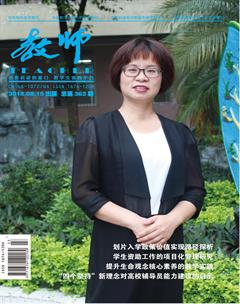以阅读为载体,培养学生综合语言运用能力
丁亚
摘 要:文章以《英语(牛津版)》八年级下Unit 3 Reading作为教学内容的一节公开课为例,分析阐述了在初中英语阅读课堂教学中,如何以阅读为载体,通过课堂活动设计的实例展示培养学生综合语言运用能力。
培养初中生的英语阅读能力是《义务教育英语课程标准(2011年版)》设定的课程培养目标,英语阅读能力的提高能够促进学生综合语言运用能力的发展。本文以《英语(牛津版)》八年级下Unit3 Reading 教学设计为例,以阅读为载体,积极培养学生综合语言运用能力。
一、目标导航,紧扣主题
本单元的标题是“online tours”,目标是培养学生利用网络获取旅游信息的能力,Reading部分是网络旅游的一个示例。因此,我将本课的教学目标设定为Learning goals:①To know how to take an online tour;②To guess the meanings of the new words;③To get the main idea of the article;④To use the information to express ideas.
二、话题导入,激发兴趣
本课一开始,我用问题“Do you like travelling? Which city have you ever been to?”导入,激发学生思考。学生根据自己的实际经历与老师交流:“I have been to Shanghai/Suzhou/Guangzhou.” 问题贴近学生日常生活,学生有话可说。接着我抛出一个问题:“Do you think it is possible to travel to all these places in one day?”一些学生回答“Yes”,一些学生回答“No”,我进一步提问:“How can we travel to all these places in one day?” 学生思维开阔,很多学生回答:“We can travel online.”此时我告诉学生今天我们要学习的就是八年级下 Unit 3“Online tours.”为了跟单元内容相契合,我又提问:“What do we use if we take online tours?”有的学生答:“We need a computer.”有的学生说:“We need a mobile phone.”在如今信息化时代,网络旅游已然不是难事,学生获取信息的渠道多,通过以上这些问题的激发,顺利导入新课的内容,学生饶有趣味地进入本课的学习。
三、问题导学,引发思考
在充分铺垫后,我问学生:“Would you please turn to Reading? Can you tell me what is our topic today?”学生快速浏览,找到本课标题“Around the World in Eight Hours. ”我将学生说出的答案写到黑板上,接着提问:“Read the headline of the article and find out what is ‘Around the World in Eight Hours.”通过引导,学生阅读文章的导读部分,找到“It is a website.” 在这里我进行阅读策略的渗透,告诉学生我们可以通过阅读文章的导读部分来获取文章的大意。本文是一个旅游网站,那导游是谁?学生阅读文章第一段并找出“Our guide is Robin. ”了解了关于这个网站的基本信息后,我们就正式学习该网站的内容:“How can we start a tour on this website?”学生带着问题阅读文章第一段落,并回答:“We just click on the ‘Touricon at the top of the page and we can visit Asia,Africa, Europe,America and others.”我把黑板设计成网站的格式,跟书本同步,并且运用板书教授新单词“click”和“icon”,直观形象。学生通过阅读回答出上面这个问题,对問题“What can we do if we want to visit a city in the USA?”更是轻而易举地回答:“We can click on the America icon.”
我继续通过问题驱动,进一步引导学生阅读:“Our guide Robin has chosen the city New York for us. Would you please read Para 2 and find out what kind of city New York is?”学生答:“It is the biggest city in the USA.”我进而提问:“What do people call New York?”学生答:“We call it‘the Big Apple.”这个问题中出现的“call ”,在本课频繁出现,所以在这里我进行拓展,如果刚才的问题是“What is New York called?”该怎么回答呢?学生思考并讨论片刻,给出答案:“It is called ‘the Big Apple.”还可以这样表达:It is a city .学生思考后也可以说出:“It is a city called ‘the Big Apple. ”于是我们进行归纳总结:A is called B 或者A/It is a ...called B ,学生参照这个句型,发散思维,能够说出很多精彩的句子,如:Our city is called Zhangjiagang. It is a city called Zhangjiagang.Our shool is called IVY Experimental High School. It is a school called IVY Experimental High School.学生在互相讨论中运用所学知识。
四、适当补充,拓展提升
本课要学习纽约的四大著名地点,我通过世界地图、纽约地图、曼哈顿地图由大到小的顺序在学生脑海中建构清晰的思维导图。学习世界地图,拓展了解七大洲和四大洋的分布:Asia, Africa,Europe,North America,South America,Oceania,Antarctica和Arctic Ocean,Atlantic Ocean ,Indian Ocean, Pacific Ocean.纽约为什么被称为“the Big Apple”?这是纽约的别称,此名的由来,主要是因为有个爵士乐手唱了一首歌:“成功树上苹果何其多,但如果你挑中纽约市,你就挑到了最大的苹果。”(There are many apples on the success tree, but when you pick New York City, you pick the Big Apple.) 意指这是一个充满机遇的城市(The city is full of chances)。学习纽约地图,补充了解纽约的五个区:Staten Island,Brooklyn, Manhattan,Queens,Bronx。而我们今天将要去往Manhattan,也称Manhattan Island。
五、理清思路,回归文本
层层铺垫,都是为课文内容的学习做好准备。我引导学生:“Read Para 3~6, and find out how many famous places are mentioned on Manhattan Island.”学生认真阅读,画出文中提到的四个地方:Wall Street,Times Square, Central Park and Broadway。本课内容简单,语言浅显易懂,但有一个句型学生初次接触:“Further on is Times Square.”为了让学生很好地了解这个表达的功能,我仍使用地图,带领学生借助曼哈顿地图一个地方接着一个地方身临其境地进行网上行(如图1所示)。
对四个地点的处理我也引导学生回归书本,认真阅读,采用不同形式来处理。关于华尔街“About Wall Street”(Para3),我通过问答引导学生阅读:
A: Where is Wall Street?
B: It is at the southern end of Manhattan Island.
A:What kind of place is Wall Street?
B:It is the world-famous trade center.
A:Whats in Wall Street?
B:There are many big companies and international banks.
关于时代广场“About Times Square” (Para 4),我运用表格形式提炼关键信息(详见表1)。
中央公园这一段落内容较为简单,同样运用表格表示关于中央公园“About Central Park” (Para5)(详见表2)。
关于百老汇“About Broadway ”(Para 6),内容比较丰富,更适合问答:
A:What is Broadway famous for?
B:It is famous for its theatres.
A:How long has it been famous for its theatres?
B:Since the early twentieth century.
A:Where does the song “Memory” come from?
B:It comes from the famous Broadway musical Cats.
六、渗透猜词,巧写板书
本课生词较多,我利用多种方式滲透猜词技能,利用图片猜词,比如click,icon,lawn;利用构词法猜词,比如southern,world-famous, international,darkness,musical;利用英文释义解释单词,比如trade, gather, huge。梳理完文章脉络后,我提出问题:“What can we do if we want to visit another city?”学生阅读最后一个段落并回答:“We can click on the ‘Backicon at the bottom of the page,pick another city and start your new tour.”这里涉及一个生词“bottom”,我在前面已经将黑板设计成网站格式,顶部有Tour,Camera,Print三个图标,底部写上Back图标,并且示意学生这就是bottom的位置,简洁明了。我的板书设计如图2所示。
七、升华文本,同步作业
最后,我要求学生参考所学文章的结构小组讨论Discussion:What can I do if I want to visit Beijing in China?学生学完本课后既可以通过这个活动来巩固如何开启一次网络旅行,又可以将所学知识运用到实际生活中,起到了升华文本的作用。作业布置:To start a new online tour of another city on the website“Around the World in Eight Hours”.
参考文献:
[1]崔允漷.有效教学:理念与策略(上)[J].人民教育,2001(6):46-47.
[2]中华人民共和国教育部.义务教育英语课程标准(2011年版)[M].北京:北京师范大学出版社,2012.

